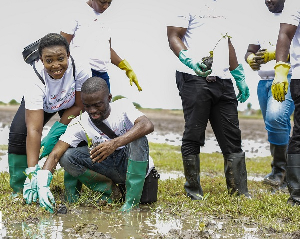Ghana has a mangrove cover of about 72.4 km2 with over 18 million trees, the Forestry Commission estimated.
However, recent studies by the Commission indicate that there is a significant decline in the country’s mangrove forests.
Many factors such as urbanization, overexploitation, pollution, wildfires, and climate change are the main causes of the depletion.
In recent years, residents in the country's wetlands have shown interest in restoring the depleted mangroves.
In Ada Foah Obane in Ada East District of the Greater Accra region, a wetland which is also declared a Ramsar site has seen significant mangrove depletion.
Eric Tetteh Addo Wusah, the Youth Committee Secretary in Obane said the depletion has occurred over the years as a result of climate change and other human activities.
A similar situation pertains in the Keta and Anloga districts of the Volta region where it became common among residents to use the plant as firewood, processing fish and building fences for homes and gardens.
Efforts by organizations to restore depleted mangrove forests
Prudential Life Insurance Ghana and Strategic Youth Network for Development (SYND), a non-governmental organisation in climate and environmental sustainability, in partnership with the Forestry Commission, have joined forces to recover depleted mangrove forests in Obane.
They took the initiative to Obane on this year's Green Ghana Day. They planted 2,000 seedlings of a variety of mangroves at the Ramsar sites in the area.
The planting was funded by Prudential Life Insurance Ghana.
The Executive Coordinator of SYND Ghana, Chibeze Ezekiel said facts on the ground and from the forestry commission show that restoring the country’s vegetation will be incomplete without wetlands being protected to support the lives of people who live in places like Obane.
He said, "More so, the project will also support the fishing occupation in the area, boost the local economy and create a safe environment for the current and future generations".
He expressed gratitude to the Forestry Commission for their expertise and Prudential Life Insurance for funding the project.
Chibeze, therefore, called on other organizations to support the initiative to cover other areas.
The planting was a pilot project that would be upscaled to cover other areas in similar situations.
The Head of Sustainability at Prudential Life Insurance Ghana, Emmanuel Hammond said they funded the initiative because it aligned with their purpose as a business. Thus, to be partners in every life and protectors of every future.
Adding that, the project also aligned with the Sustainable Development Goals (SDGs) and Prudential Life’s sustainability goals of enhancing education, health and safety.
He commended the fact that the staff of Prudential Life, community members, the forestry commission, and the volunteers of SYND were directly involved to ensure that every seed was planted and optimistic that they would be well cared for.
Mr. Hammond added that they are considering a five-year plan to plant more mangroves to improve the community’s resilience to environmental challenges.
“Apart from the 2000 mangrove seedlings planted at Obane, Prudential Life has supported the distribution of 15000 seedlings in other communities since 2022,” Hammond told the media.
According to the insurance firm, the project will help to build climate change resilience communities in the country to ensure a safer and more secure future for all.
Importance of mangrove forests
Mangroves play an important role in the ecosystem. Research by the USA Forest Service showed that mangrove forests absorb roughly 50 times more carbon dioxide emissions than any other tree. It also absorbs other greenhouse gases from the atmosphere.
The roots of mangroves serve as shelter for life underwater. They slow down the flow of water. This leads to a build-up of soil which otherwise would have been eroded.
Freshwater birds use the mangroves as their shelter.
Mangrove forests, when managed properly, serve as a source of livelihood for residents through fishing.
Mangroves also control the currents of a lake/river, especially in estuaries. This helps to prevent the disasters relating to flooding which commonly occur in coastal areas.
Regional News of Tuesday, 11 June 2024
Source: Albert Kuzor, Contributor

















